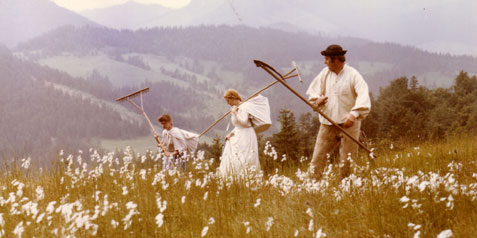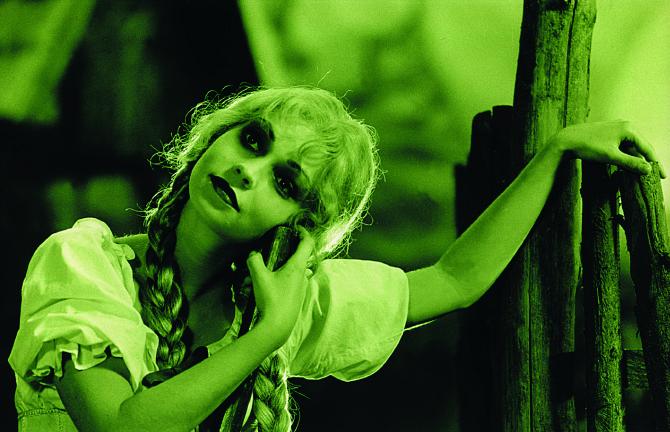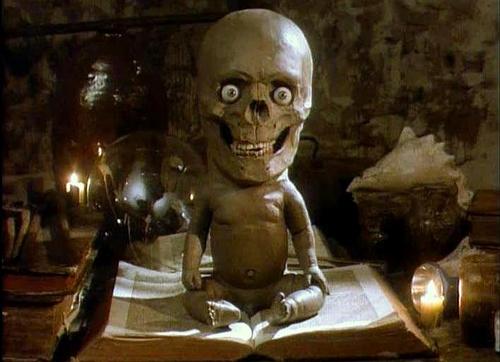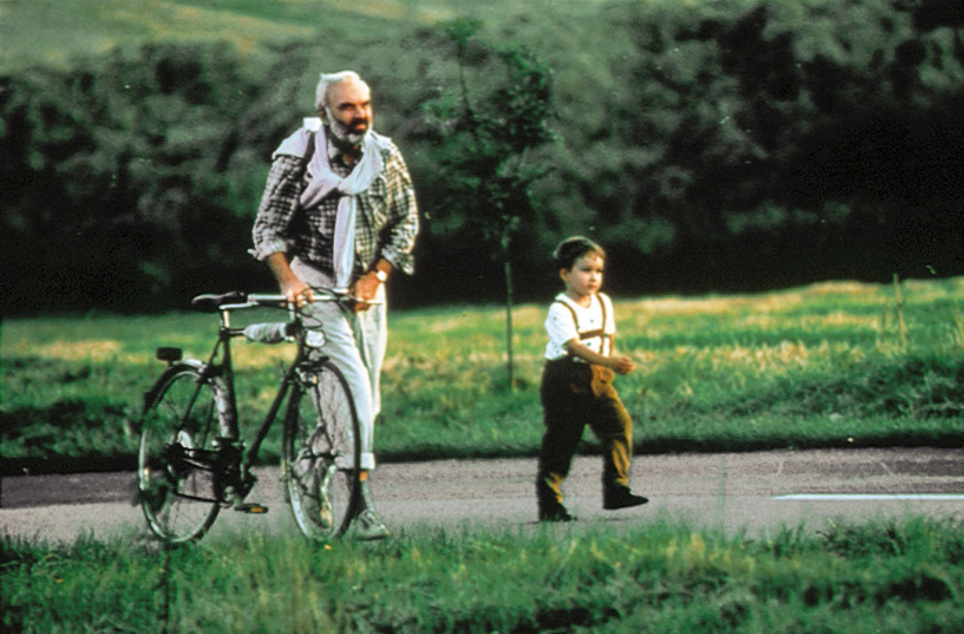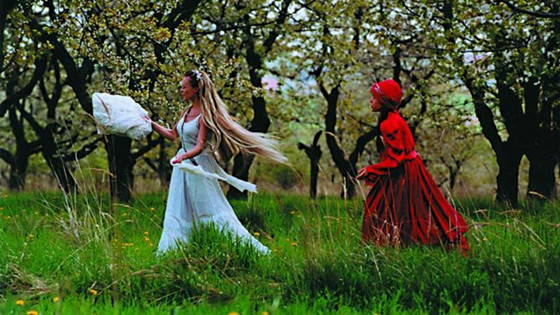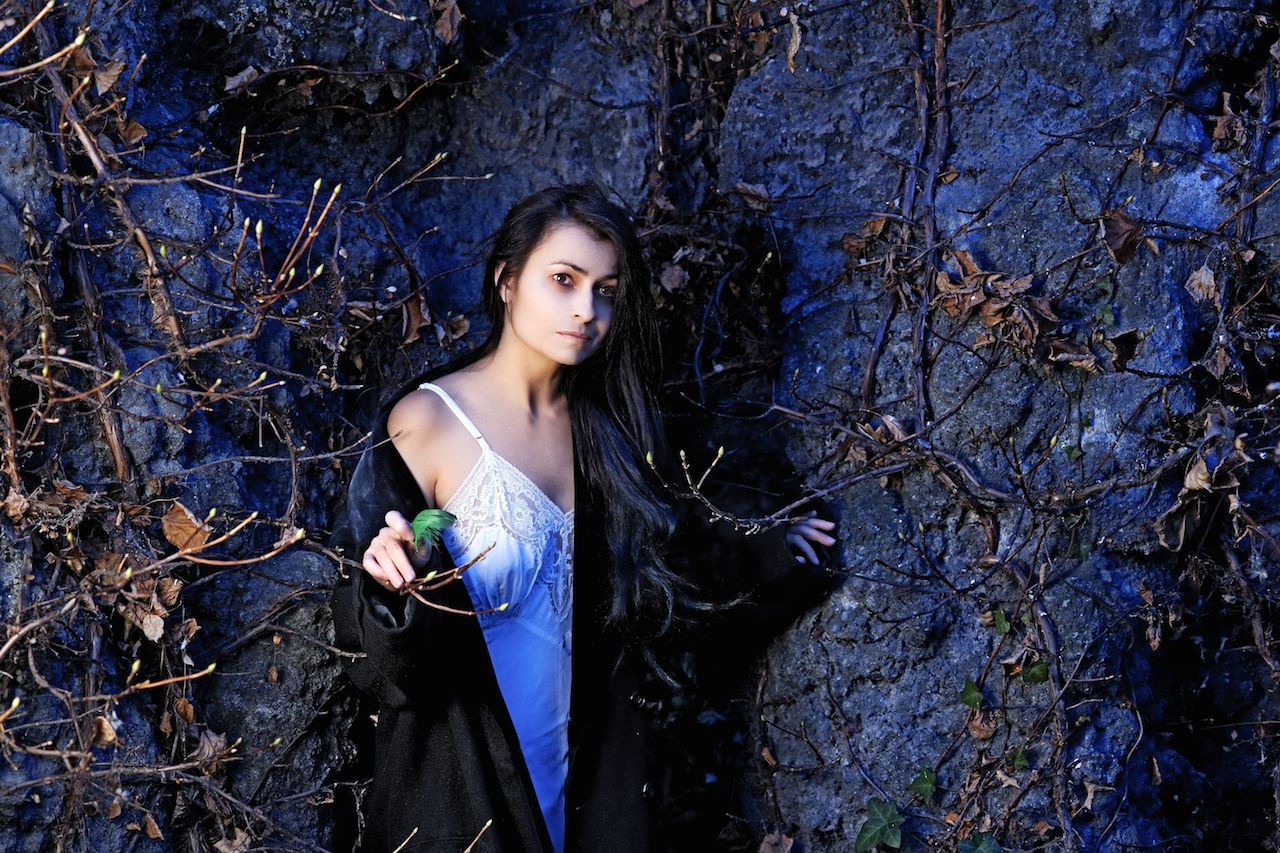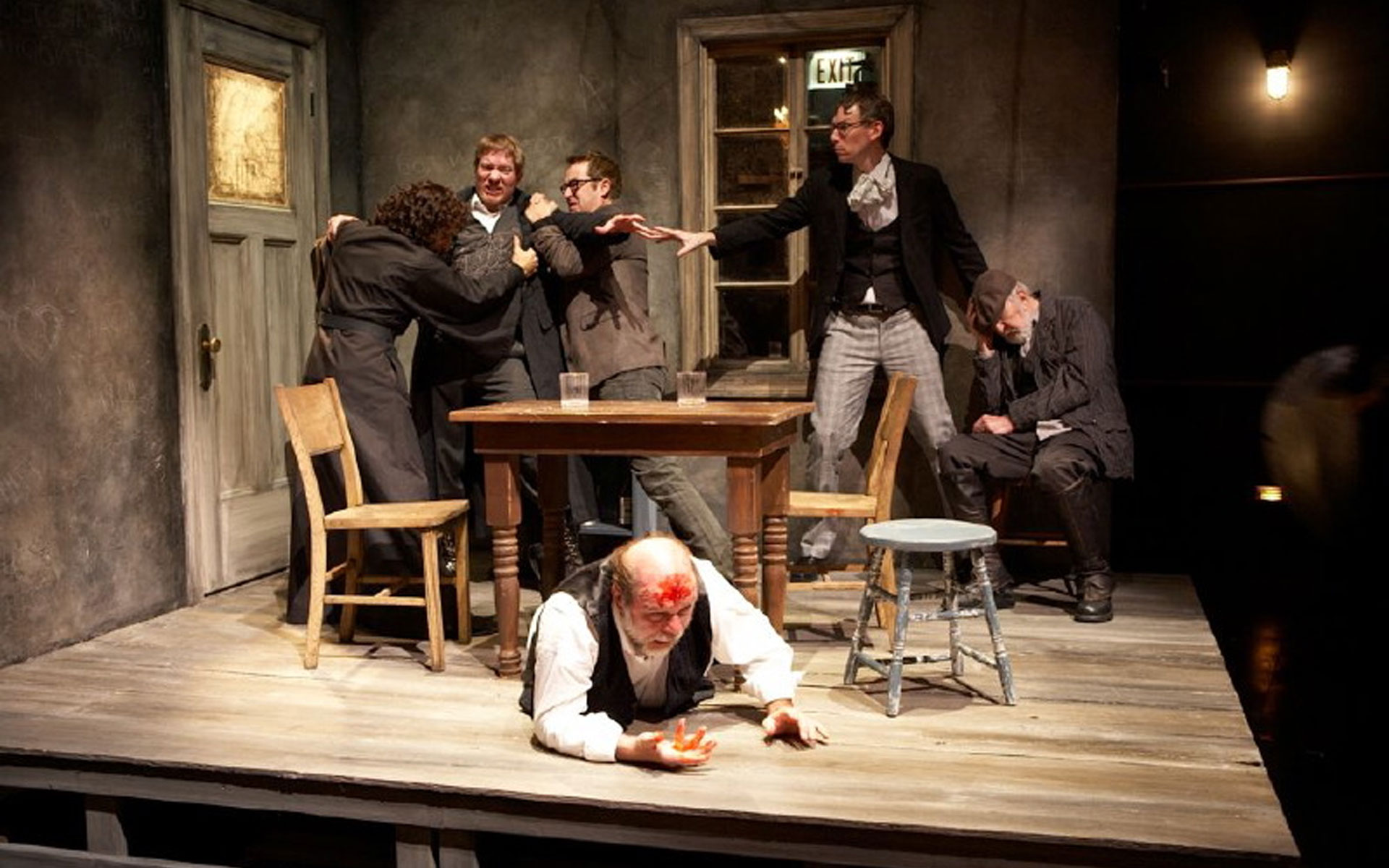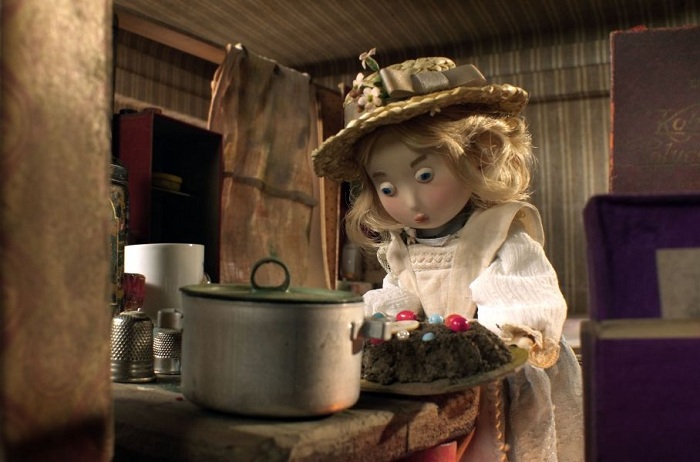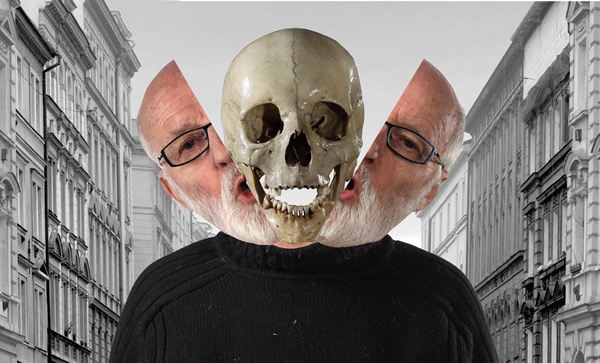27. The Millennial Bee (1983). Dir. by Juraj Jakubisko
Emir Kusturica meets David Lynch. This is Jakubisko’s best-known work, an adaptation of Peter Jaros’s novel that spans the 30 years in the life of a Slovak peasant family, up until the turmoil of World War I. The family’s business is beekeeping, and the changing of the worlds from agrarian to urban, the intrusion of the bigger world into a village idyll, is presented by Jakubisko with a series of surreal and astonishing images.
The queen bee here symbolizes the center of home and hearth, the originator and keeper of life. Which can be a bit crazy at times-the list of astonishing and unique scenes runs the gamut here. The rains of honey and frogs. The white horse in the church. The communal racing down the hill on coffins, with crosses used as steering devices. Those and many more combine to present a crazy collage, masterfully scored by organ-grinder music that enhances this bittersweet carnival.
28. Horror Story (1993). Dir. by Jaroslav Brabec
The fall of communism freed up the writers and filmmakers to explore the “forbidden themes” and to back them up with fascinating imagery. This film is an adaptation of a novel by a very original author, painter, and philosopher Josef Vachal, and it’s horribly amazing to look at (even if story lines get murky at times). It intertwines the images born in the head of a writer of “pulp” horror stories for kitchen maids, liberally sprinkling them with nudity and gore.
Along the way, it takes us through that other early XXth century low-class medium, cinema, from silent to contemporary days. Re-animated corpses and Victorian-era beauties, exotic lands and fantastic inventions follow each other in a phantasmagoric succession. The cinematography is great, but what makes it truly striking is the use of color, from bw to you name it-red, green, sepia, mauve, etc. In short, a colorful and horribly amazing experience.
29. Faust (1994). Dir. by Jan Svankmajer
With Alice (1988), Svankmajer made a transition from shorts to features. His trademark stop-motion and Claymation are here, but gradually he begins to introduce human characters to his bizarre worlds. This is not so much an adaptation of the Faust legend, but rather could be titled (like the Quay brothers film), the cabinet of Jan Svankmajer.
Combining live-action, Claymation, stop-motion, puppet theatre, and theatre of the absurd, Svankmajer creates a colorful and unforgettable collage, where a chance encounter drags the protagonist (and the viewer) down a dark and humorous path. Along the way, the very illusory nature of theatre, opera, and puppetry is shown and explored, down to the mechanism behind the automatons. If all Faustian deals are this fantastic, don’t hesitate to make one.
30. Kolya (1996). Dir. by Jan Sverak
The Oscar was well deserved by this heartwarming, funny, and visually arresting film. Its main hero is the former Philharmonic cellist, blacklisted by the communist regime and forced to make money playing at the crematorium ceremonies. Played with verve and poignancy by the director’s father, Louka is an avowed bachelor who hates all things Soviet. Marrying a Russian woman for money, he finds himself left with caring for her 5-year old moppet of a son.
The situation is exacerbated by the fact that neither speaks the other’s language, and made further comical by the many “false friend” words that exist between Czech and Russian languages. But the friendship that forms is very real, and Louka re-examines his life and betters it. The visual side of the film is top-notch, with careful attention to detail and recreation of 1988, the very lively and transitionary time in Czech history.
31. Wild Flowers (2000). Dir. by F.A. Brabec
One of the most beautiful films ever made, this is an adaptation of Karl Erben’s 1853 collection of fairy tale-ballads (which earlier inspired several of Antonin Dvorak’s symphonic poems). Visuals make this film and propel it forward. Brabec is mainly a cinematographer, and he brings his eye for the composition into this picture.
The film benefits further from a fantastic score by the legendary Jan Jirasek and the art direction of Juraj Jakubisko (see #’s 18 and 26), who also produces this film by his long-time cameraman. Each tale comes with own color scheme and unique atmosphere, and they are all simply amazing and haunting. Be forewarned-these are very scary fairy tales, Death being either always around the corner or on screen itself.
Many of these tales are unforgettable. The water sprite with floating weeds hair who “marries” the women by drowning them. The black-eyed prince who meets his golden-haired beloved in the autumn forest (tragedy soon to follow). Death as an old woman with a staff wandering the sun-scorched roads, making its rounds.
A bride who prays for her soldier groom to come back to her-and gets him, but what a demonic gleam he has in his eyes (be careful what you wish for)! And the momentous imagery is equally memorable-gallows with the noose swirling in the wind, shattered window, grave covered in lilacs. Macabre never looked more arresting and memorable.
32. Zelary (2003). Dir. by Ondrej Trojan
A romantic epic that manages to avoid saccharine sentimentality and melodrama. Set in 1943, it focuses on a young nurse in the Nazi-occupied Prague, who is nearly discovered helping the Resistance, and has to flee to the Slovak country side. Taking refuge with a young peasant whose life she once saved, she has to accustom herself to the village life and to a man she now lives with. Sounds like a premise for a comedy, but it’s in fact a mix of thriller and classical tragedy.
The village and the surrounding nature are incredibly beautiful, but are very far from being idyllic and bucolic. Here, the alcoholism is rampant, and violence, including rape, occurs on almost daily basis. Add to that the ever-present threat of Gestapo, and you can see how even this lovely place can be made hellish by humans. But it’s very atmospheric, with breathtaking cinematography and music, and progresses at a leisurely but well-measured pace.
33. The Karamazov Brothers (2008). Dir. by Petr Zelenka
If anything else, Zelenka is one of the most versatile modern filmmakers. Having made comedies, dramas, and documentaries, here he tackles his biggest challenge yet-Dostoyevsky. He succeeds in creating a memorable experience by simultaneously playing with the form and simplifying it. Here, the action takes place at an abandoned polish metal plant.
A troupe of actors rehearse a stage adaptation of the legendary Dostoyevsky novel (brought to stage with great acclaim by the legendary New Wave director Evald Schorm-see #13). Already, the frills and melodrama are removed, and the environment is as bare-bones as can be. Perfectly suited for delving deep into themes the great Russian expounded on so well-miscommunication, trying to achieve connection and understanding, saving of one’s soul in a hellish world. But here art also imitates life.
As it often happens in theatrical productions, nothing is certain until the show goes up. This motley international troupe (featuring many Eastern Europeans from different countries and even a Japanese actor) transposes the themes of miscommunication onto their relationship with each other, raising a question-can the grasp the material in time?
The play-within-a-play structure works to a great effect here, recalling similar works like Rivette’s “Paris Belongs to Us” and Malle’s “Vanya on 42nd Street”. Add to it the music that fits the imagery pitch-perfectly, and you’re in luck if you see this film-you’ll have a backstage pass to either a masterpiece or a potential train wreck.
34. Toys in the Attic (2009). Dir. by Jiri Barta
The largest-scale project to date from the great Czech animator, this is the dusty and non-CGI “Toy Story”, Czech-style. The toys here are relics of the wind-up era, stashed at the attic where they go in living.
The plot here is rather thin-the Buttercup doll is kidnapped by the henchmen of the Evil Land dictator (a dark, bald bust with shades and cigar), and it falls to the Teddy Bear, the mechanical mouse, and the Quixotic marionette to rescue their favorite. But Barta creates a one-of-a-kind world of puppets, Claymation, and found objects, into which he breathes life with the good ol’ stop motion technique.
Words cannot describe all the wonders-the toys themselves, the meticulous surroundings (where every pin and spider web seem to have a character of their own). Unless Barta finally finishes his Golem project (stalled for over 20 years), this and 1986 The Pied Piper will remain his monumental feature-length contributions to the art of stop-motion. But what contributions those are!
35. Surviving Life (2010). Dir. by Jan Svankmajer
At 80, Svankmajer the magician shows no signs of stopping. His next highly-anticipated feature is out this year. In Surviving Life, he continues to explore the human psyche in the wackiest way possibly-with wildly inventive animation. Here he tries a different method, placing live actors in a flat and collage world. He amusingly explains it in a brief foreword, citing lack of funds.
The main hero begins seeing weird and not altogether bad dreams (featuring a mysterious beauty clad in red). When residues of his dreams begin to spill into his everyday life, he becomes concerned and starts seeing a psychoanalyst, who cheerfully starts exploring his psyche (to approval of Freud and Jung portraits on her wall).
Be prepared to see ego, id, super-ego, and others to come to life in the most amusing ways possible. And cheers to Svankmajer, the living legend and still a guiding life of Czech weirdness.
